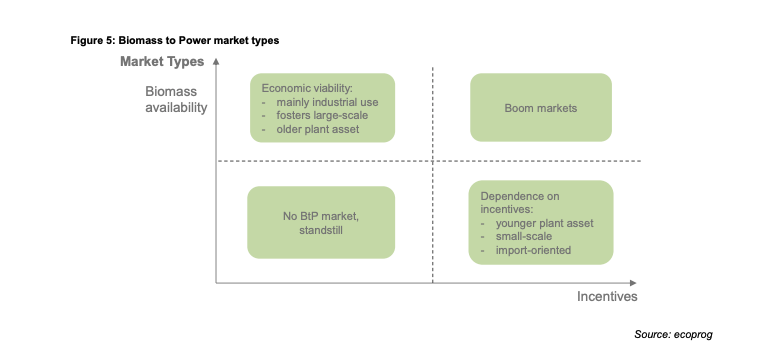
Biomass to Power: Economic viability and biomass potential
January 24, 2024
By ecoprog
An excerpt from the ecoprog Biomass to Power world market report for biomass power plants 2023/2024 reveals key economic factors informing the viability of the industry.
 Biomass to power market type. Source: ecoprog
Biomass to power market type. Source: ecoprog In early 2023, there were about 4,850 active biomass power plants worldwide, reaching an installed electrical capacity of around 81.5 GWel. In our forecast, we expect about 5,870 BMPPs with a capacity of around 95.5 GWel to be commissioned by the end of 2032.
The subsidization of renewable energies and the development of domestic energy sources from existing waste material, e.g. wood waste or bagasse, are the most important reasons for this growth.
In general, the two most important factors for the economic viability of a biomass to power project are the biomass fuel availability and the subsidies available in the country.
With these two factors, a rough categorization of market types can be done.
Compared to fossil energy sources, biomass fuels are inferior in terms of calorific value. Without considering the adverse climate effects, it is more profitable to incinerate coal or natural gas. Due to their low calorific values, transporting biomass fuels is usually not economically viable and local availability is important.
Several preconditions have to be met for electricity generation from biomass to be economically viable without financial incentives from third parties:
- The existence of larger biomass amounts, without valuable options for an economic use competing at the location where the biomass emerges.
- A high energy demand at this location, ideally both for heat and electricity. This energy need becomes even more important as a location factor if other energy sources can only be tapped at high costs at peripheral sites.
In the coming years, carbon capture and storage or utilization at biomass power plants (Bioenergy with Carbon Capture and Storage, BECCS) may represent an opportunity for electricity generation from solid biomass.
In the future, negative emissions could generate revenue from CO2 removal certificates.
Print this page